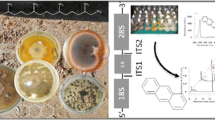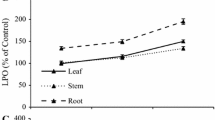Abstract
Following their exposure to anthracene, the roots of Populus nigra L. Loenen showed traces of 9 substances classed as products of biodegradation. The main substances detected were phthalic acid and 9,10-anthraquinone, followed by hydroxy-anthracene and methoxyanthracene and five other compounds which could not be identified. Due to the relatively low concentration of degradation products found in the roots, further degradation to lower molecular compounds are discussed. The presence of 9,10-anthraquinone as the main product of the degradation of anthracene was also evident in the control tests with unplanted sandy substrate, although the content was higher in the planted series of tests. As a non-sterile approach was chosen, it may be assumed that a microbial degradation for 9,10-anthraquinone took place in the control series. However, it is difficult to differentiate clearly between a microbial degradation of anthracene in the substrate and metabolization in the roots due in part to the absence of specific degradation products in the various reaction areas.
Similar content being viewed by others
References
Ahn S, Lion L W, Schuler ML (1996): Microscale-Based Modeling of Polynuclear Aromatic Hydrocarbon Transport and Biodegradation in Soil. Biotechnol & Bioengineering 51, 1–14
Baiocchi C, Marengo E, Roggero MA, Giacosa D, Vietto L, Toccori S (1994): A Chromatographie and chemometric study of the bark phenolic compounds of two poplar clones with different resistance to Disosporium populeum. Chromatogr 39, 481–489
Baiocchi C, Marengo E, Roggero MA, Giacosa D, Giorcelli A, Toccori S (1995): Chromatographic and Chemometric Investigation of the Chemical Defence Mechanism of Poplar Tree Genotypes against a Bark Fungine Parasite. J. Chromatogr 715, 95–104
Bezalel L, Hadar Y, Fu PP, Freeman JP, Cerniglia CE (1996): Initial Oxidation Products in the Metabolism of Pyrene, Anthracene, Fluorene, and Dibenzothiophene by the White Rot Fungus Pleurotus ostreatus. Appl Environ Microbiol 62, 2554–2559
Briggs G, Bromilow RH, Evans AA (1982): Relationship between Lipophilicity and Root Uptake and Translocation of Non-ionised Chemicals by Barley. Pestic Sc 13, 495–504
Bundt J (1991): Bestimmung von Mineralölinhaltstoffen und deren Abbauprodukte im Boden unter besonderer Berücksichtigung aromatischer Verbindungen. Diss. Univ. Hamburg Cerniglia CE, Sutherland JB, Crow SA (1992): Fungal Metabolism of Aromatic Hydrocarbons. In: G. Winkelmann (Hrsg.): Microbial Degradation of Natural Products, VCH, Weinheim, 193–217
Dean-Ross D, Cerniglia CE (1996): Degradation of pyrene by Mycobacterium flavescens. Appl Microbiol & Biotechnol 46, 307–312
Grifoll M, Casellas M, Bayona JM, Solanas AM (1992): Isolation and Characterization of a Fluorene-Degrading Bacterium: Identification of Ring Oxidation and Ring Fission Products. Appl Environ Microbiol 58, 2910–2917
Guerin WF, Jones GE (1988a): Two-Stage Mineralization of Phen-anthrene by Estuarine Enrichment Cultures. Appl Environ Microbiol 54, 929–936
Guerin WF, Jones GE (1988b): Mineralization of Phenanthrene by a Mycobaterium sp. Environ Microbiol 54, 937–944
Harms H (1981): Aufnahme und Metabolismus polycyclischer aromatischer Kohlenwasserstoffe (PCKs) in aseptisch kultivierten Nahrungspflanzen und Zellsuspensionskulturen. Landbauforschung Völkenrode 31, 1–6
Harms H (1983): Uptake and Conversion of Three Different 5-Ring Polycyclic Aromatic Hydrocarbons (PAHs) in Cell Suspension Cultures of Various Chenopodiaceae-Species. Z Naturforsch 38 c, 382–386
Harms H (1996): Bioaccumulation and metabolic fate of sewage sludge derived organic xenobiotics in plants. Sci Total Environ 185, 83–92
Harms H, Langebartels C (1986): Standardized Plant Cell Suspension Test Systems for an Ecotoxicologic Evaluation of the Metabolic Fate of Xenobiotics. Plant Science 45, 157–165
Heitkamp MA, Freeman JP, Miller DW, Cerniglia CE (1988): Pyrene Degradation by a Mycobacterium sp.: Identification of Ring Oxidation and Ring Fission Products. Appl Environ Microbiol 54, 2556–2565
Jacob J, Grimmer G (1987): Capillary gas chromatographical analysis and mass spectrometric identification of polycyclic aromatic hydrocarbon metabolites from biological materials. Rev Anal Chem 9, 49–89
Käcker T (2000): Bildung und Verbleib von PAK-Abbauprodukten in einfach- und mischkontaminierten Bodenmaterialien. Diss. Univ. Hamburg
Kästner M, Mahro B (1993): Der mikrobielle Abbau polyzyklischer aromatischer Kohlenwasserstoffe (PAK) in Böden und Sedimenten: Mineralisierung, Metabolitenbildung und Entstehung gebundener Rückstände. Bioengineering 9, 50–57
Karimi-Lotfabad S, Pickard MA, Gray MR (1996): Reactions of Polynuclear Aromatic Hydrocarbons on Soil. Environ Sci Technol 30, 1145–1151
Kelley, I, Freeman JP, Evans FE, Cerniglia CE (1993): Identification of Metabolites from the Degradation of Fluoranthene by Mycobacterium sp. Strain PYR-1. Environ Microbiol 59, 800–806
Kuhn A (1999): Identifizierung von Transformationsprodukten polyzyklischer aromatischer Kohlenwasserstoffe (PAK) in Pflanzenwurzeln sowie die Akkumulation und das phytotoxische Potential der PAK am Beispiel von Populus nigra L. cv. Loenen. Diss. FB Biologie J. W. Goethe-Univ. Frankfurt/Main
Kuhn A, Ballach H-J, Wittig R (1998): Seasonal Variation of the Distribution of Polycyclic Aromatic Hydrocarbons in Poplar Leaves. Fresenius Environ Bull 7, 164–169
Kuhn A, Ballach H-J, Wittig R (2003): Research Articles: Special Issue ‘Impact Studies on PAHs’: Part HI: Studies on the Biodeg-radation of 5 PAHs (Phenanthrene, Pyrene, Fluoranthene, Chrysene and Benzo(a)pyrene) in the Presence of rooted Poplar Cuttings. ESPR — Environ Sci & Pollut Res (OnlineFirst: DOI: http://dx.doi.org/10.1065/espr2003.04.150.3)
Mahaffey WR, Gibson DT, Cerniglia CE (1988): Bacterial Oxidation of Chemical Carcinogens: Formation of Polycyclic Aromatic Acids from Benzo(a)anthracene. Appl Environ Microbiol 54, 2415–2423
Mueller JG, Chapman PJ, Blattmann BO, Pritchard PH (1990): Isolation and Characterization of a Fluoranthene-Utilizing Strain of Pseudomonas paucimobilis. Appl Environ Microbiol 56, 1079–1086
Narro ML, Cerniglia CE, Baalen C van, Gibson DT (1992): Metabolism of Phenanthrene by the Marine Cyanobacterium Agmellum quadruplicatum PR-6. Appl Environ Microbiol 58, 1351–1359
Polder MD, Hulzebos EM, Jager DT (1995): Validation of Models on Uptakte of Organic Chemicals by Plant Roots. Environ Toxicol & Chem 14, 1615–1623
Richnow HH, Eschenbach A, Mahro B, Scifert R, Wehrung P, Albrecht P, Michaelis W (1998): The use of 13C-Labelled Polycyclic Aromatic Hydrocarbons for the Analysis of their Transformation in Soil. Chemosphere 36, 2211–2224
Schneider J, Grosser R, Jayasimhulu K, Xue W, Warshawsky D (1996): Degradation of Pyrene, Benz(a)anthracene, and Benzo(a)pyrene by Mycobacterium sp. Strain RJG-135 Isolated from Former Coal Gasification Site. Appl Environ Microbiol 62, 13–19
Schwab AP, Al-Assi AA, Banks MK (1998): Plant and Environment Interactions- Adsorption of Naphthalene onto Plant Roots. J Environ Qual 27, 220–224
Schwarz OJ, Jones LW (1997): Bioaccumulation of Xenobiotic Organic Chemicals by Terrestrial Plants. In Wang W, Gorsuch J W, Hughes JS (eds.): Plants for Environmental Studies. CRC Press, Boca Raton, 417–449
Sutherland JB, Rafii F, Khan AA, Cerniglia CE (1995): Mechanisms of polycyclic aromatic hydrocarbon degradation. In Young LY, Cerniglia CE (eds.): Microbial transformation and degradation of toxic organic chemicals. John Wiley & Sons Ltd., New York, 269–306
Wischmann H (1997): Analytik von PAK-Abbauprodukten in Bodenhorizonten und Boden/Kompost-Gemischen. Diss. Univ. Hamburg
Wischmann H, Steinhart H (1997): The Formation of PAH Oxidation Products in Soils and Soil/Compost Mixtures. Chemosphere 35, 1681–1698
Wittig R, Ballach H-J, Kuhn A. (2003): Exposure of the Roots of Populus nigra L. cv. Loenen to PAHs and its Effect on Growth and Water Balance (Part I). ESPR — Environ Sci & Pollut Res (OnlineFirst: DOI: http://dx.doi.org/10.1065/espr2003.04.150.l)
Wunder T, Kremer S, Sterner O, Anke H (1994): Metabolism of the Polycyclic Aromatic Hydrocarbon Pyrene by Aspergillus niger SK 9317. Appl Microbiol & Biotechnol 42, 636–641
Zink G (1995):Identifizierung von Metaboliten beim mikrobiellen Abbau von PAK. Diss. Univ. Berlin
Author information
Authors and Affiliations
Corresponding author
Rights and permissions
About this article
Cite this article
Ballach, H.J., Kuhn, A. & Wittig, R. Biodegradation of anthracene in the roots and growth substrate of poplar cuttings. Environ Sci & Pollut Res 10, 308–316 (2003). https://doi.org/10.1065/espr2003.04.150.2
Received:
Accepted:
Issue Date:
DOI: https://doi.org/10.1065/espr2003.04.150.2




